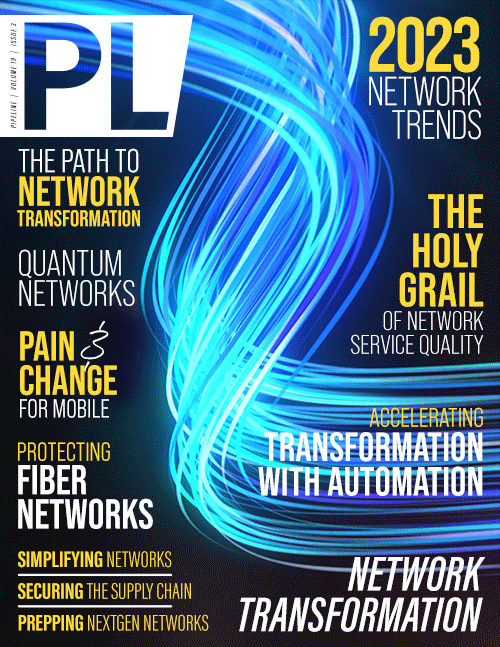Innovation, Automation and the
Path to Network Transformation
By: Patti A. Reali

Innovation is a top priority for organizations all over the globe and most are in various states of digital transformation—telecoms, cable and mobile network operators are no exception.
In its Top Ten Predictions for the Future of Digital Innovation, the research firm IDC predicts that “By 2026, 75 percent of market leaders will have systemic, structured digital innovation programs and investments that support ongoing iterative innovation, enabling growth, scale, agility and resilience.” In addition, data-driven insights will be key to this innovation, with 85 percent of CEOs of the G2000 demanding that senior leaders deliver data-driven insight into innovation activity including developer efficiency and business outcomes by 2025. And the pressure is on communications service providers (CSPs) to use innovation to meet top priorities, including positive customer experience, overall customer satisfaction, operational efficiency, sustainability, cost savings, agility and business resilience, according to a July 2022 IDC survey of enterprise spending.
For today’s CSPs, transformation is a process that includes addressing complexity, streamlining processes and driving efficiencies through intelligent automation using a mix of tools and technologies—cloud-native infrastructure and serverless, container technologies—that can automate their networks and provide observability across their varied and complex infrastructures and operations. In this article, Pipeline delves into insights from the recent SCTE Cable-Tec Expo on innovation, automation, and network transformation.
The urgency of cable network transformation
Cable service providers are deeply enmeshed in this network transformation journey, driven by an array of factors: competition from fixed and mobile service providers; pandemic-induced demand pressure for higher speeds and more symmetrical bandwidth for video streaming, videoconferencing and other applications; the availability of billions of dollars in government funding from the U.S. infrastructure bill to fund broadband expansion and upgrades; the push for fixed-mobile network convergence for seamless connectivity; and the need for better OpEx and TCO, among others.
Looking beyond the value of the network itself, however, CSPs are also seeking to identify more revenue-generating services, and to improve service and deliver experiences that create customer loyalty.
Leaders are recognizing an accelerated pace for industry innovation. At the Expo late last year, Phil McKinney, CEO of CableLabs said, “It is beyond anything I've ever experienced,” he said, noting that innovation used to take up to 10 years to get broad adoption. “It's no longer decades or years. In some cases, for applications, it can be months or even weeks.”
CableLabs, the industry’s chief R&D organization, defines the path to network transformation as the 10G Initiative. It envisions infrastructure that is access network agnostic, delivers multi-gigabit speeds, lower latency and more robust security, cuts space and power needs and reduces operational costs while increasing new product development and service deployment velocity. Over the longer term, it also aims to bring the convergence of fixed and wireless networks into tighter focus for operations over a single converged core.
Cable operators are investing significant time, money and human resources to update and expand their infrastructure to accomplish these goals and remake their platforms and operations to manage and optimize the pace of innovation. They’re accomplishing this with IT systems, tools and technologies that add virtualization, open, cloud-native software, containerization, and automation to enable better control, visibility, telemetry, and testing and reporting, among other capabilities.
Liberty Global embodies one example of the variability of cable infrastructure—it owns and operates Virgin Media-02 in the UK, VodafoneZiggo in The Netherlands, Telenet in Belgium, Sunrise in Switzerland, Virgin Media in Ireland and UPC in Slovakia with 85 million fixed line and mobile customers across nine countries in Europe. EVP and CTO Enrique Rodriguez has publicly emphasized the need for automation, given the different types of networks both within and across its footprint: “I don't believe we've seen even 10 percent of the benefits that we're going to get from automation,” he noted at the Cable-Tec Expo technology leadership panel last year.
In EMEA markets for example, Liberty Global is already moving along with its version of FMC with Wi-Fi playing an increasingly important role in its value proposition to customers. Rodriguez noted that in mid-September, Liberty Global launched a Wi-Fi Guarantee, combining Wi-Fi and mobile network connectivity for a seamless end-to-end user experience.
The enterprise market is also part of cable operator fixed-mobile convergence (FMC) targets. Most of Liberty Global’s B2B customers take both mobile and fixed connectivity services, using wireless access as a backup/failover connection option, which is of critical importance to business operations. MNOs like Liberty with deep fiber networks are connecting mobile-based stations to their fixed fiber infrastructure



















